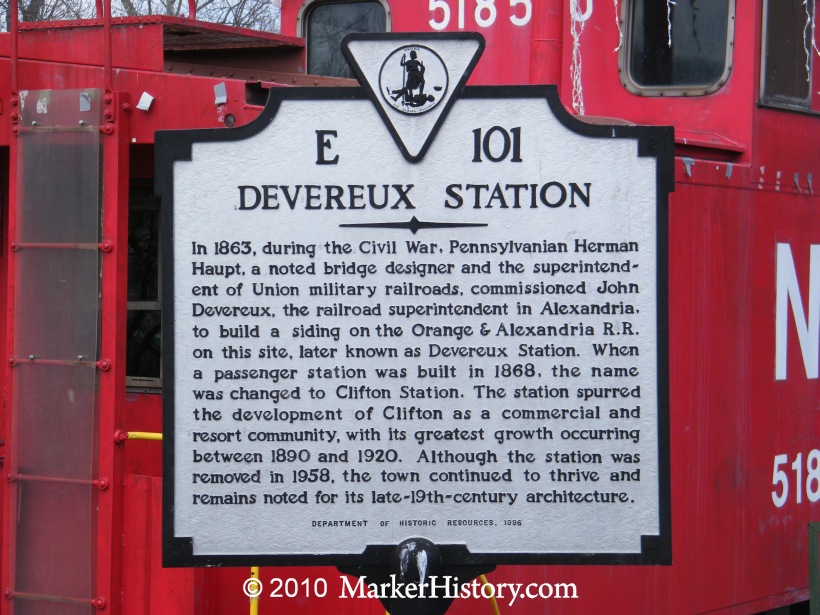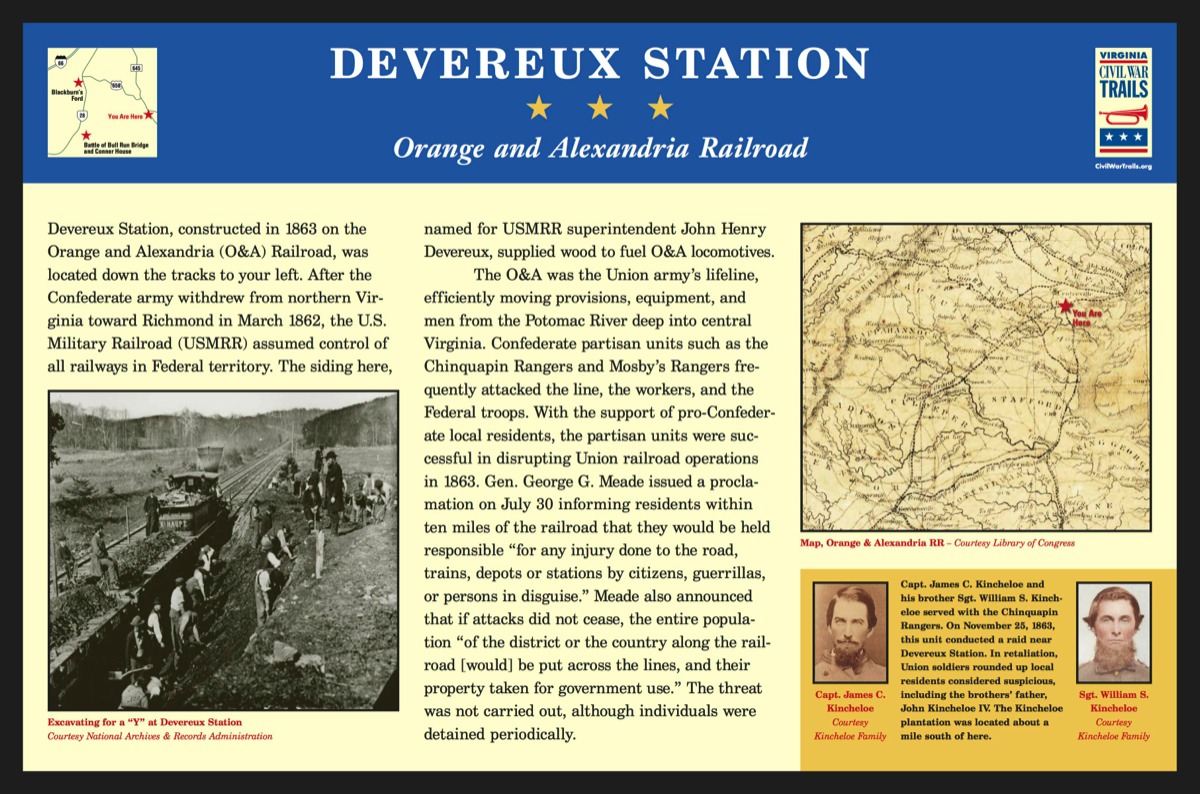





Without traffic lights or a direct postal service, Clifton remains an enchanting relic of a time past. Functioning a few decades behind the rest of the world, Clifton's façade is composed of houses that are almost all over one hundred and twenty years old. White picket fences line main street, rustic lanterns and barrels full of flowers adorn the small hub of town. Featuring a handful of shops—a general store, florist and antique collector—Clifton's economy has not developed much since its founding days as a small railroad station.

Originally known as Devereux Station, Clifton was borne as a direct result of the Civil war. In 1861, the Union army incorporated the O&A (Orange and Alexandria) railroad company into their military system. Serving as the southern-most point of the Union army, Clifton housed soldiers placed to guard against a Confederate invasion. Oftentimes troops marched through town, fighting small battles and preparing to set up camp along the creek. After the war was over, Harrison Otis (commonly credited as being the original developer of the town) helped to modernize the railroad, and in doing so, he purchased Devereux Station.
After failed attempts at cultivating grapes in his vineyard, Otis opened a hotel in the building that now serves as the Hermitage Restaurant. The town quickly became a retreat for the wealthy of Washington. Although its previous reputation preceded it as great hunting grounds (George Washington and Lord Fairfax used to ride here on their hunts), its new fame was the saloons, hot springs and peaceful small-town pace. Clifton became the first community in Fairfax to have power in 1925 with the coming of the Bull Run power company. The first high school in the county was also opened here, with students shuttled in by train. The Buckley store, built in 1900, was another major factor in the town's growth. Claiming to have "everything from a pin to a plow" the store was later closed and converted into the Heart and Hand restaurant.
A few of Clifton's most notable guests include actress Helen Hayes who frequently summered here and Jeff Arch who wrote his famous screenplay for Sleepless in Seattle in a house on Main street. Events throughout the year such as Clifton Day, held the second Sunday of each year, allow tourists to come enjoy the town. Initially intended for the townspeople to become better acquainted with neighboring towns, as many as 20,000 people come to Clifton Day to enjoy the hundreds of craftsmen, artists, antique dealers and food vendors. The Clifton Woman's club sponsors an annual Spring Home Tour and Christmas Candlelight Home Tour. In June, the 5K Caboose Run, hosted by the Clifton Betterment Association, fundraises proceeds to donate to local charities. The Community Hall—built in 1995, this is Clifton's most recent addition—is decorated with four seasonal murals of the town painted by Lee Ruck.
If you are interested in taking a walking tour, be sure to check out the following spots! The Beckwith House, also called "the Homestead", was built in 1771 and is Clifton's oldest house. The Mayhugh Tavern was built in 1870 and operated by Gustie "Grandpap" Mayhugh who strived to "run an orderly and genteel bar". The Clifton Baptist Church (across the street from the Canary Cottage!) was built in 1876, has a spire steeple and gothic windows. The Hetzel House was named after its resident Susan Riviere Hetzel, who founded the National Society of the Daughters of the American Revolution. The Helen Hayes house was built in 1908 and the actress thoroughly enjoyed her stays there as the guest of her nephew and his wife. The Harris House is the second oldest in Clifton, built in 1850. The Lucy Virginia Davis Buckley House was built in 1913. It has been the home to two mayors and once served as an elementary school and high school. Lastly, the Southern Railway Caboose is a beautiful bright red landmark designating the spot of the original Devereux station. Aptly nicknamed the "Brigadoon of Virginia, Clifton was declared a national historic district by the U.S. Department of Interior in 1984.
by Hilary Hodge 2002
After failed attempts at cultivating grapes in his vineyard, Otis opened a hotel in the building that now serves as the Hermitage Restaurant. The town quickly became a retreat for the wealthy of Washington. Although its previous reputation preceded it as great hunting grounds (George Washington and Lord Fairfax used to ride here on their hunts), its new fame was the saloons, hot springs and peaceful small-town pace. Clifton became the first community in Fairfax to have power in 1925 with the coming of the Bull Run power company. The first high school in the county was also opened here, with students shuttled in by train. The Buckley store, built in 1900, was another major factor in the town's growth. Claiming to have "everything from a pin to a plow" the store was later closed and converted into the Heart and Hand restaurant.
A few of Clifton's most notable guests include actress Helen Hayes who frequently summered here and Jeff Arch who wrote his famous screenplay for Sleepless in Seattle in a house on Main street. Events throughout the year such as Clifton Day, held the second Sunday of each year, allow tourists to come enjoy the town. Initially intended for the townspeople to become better acquainted with neighboring towns, as many as 20,000 people come to Clifton Day to enjoy the hundreds of craftsmen, artists, antique dealers and food vendors. The Clifton Woman's club sponsors an annual Spring Home Tour and Christmas Candlelight Home Tour. In June, the 5K Caboose Run, hosted by the Clifton Betterment Association, fundraises proceeds to donate to local charities. The Community Hall—built in 1995, this is Clifton's most recent addition—is decorated with four seasonal murals of the town painted by Lee Ruck.
If you are interested in taking a walking tour, be sure to check out the following spots! The Beckwith House, also called "the Homestead", was built in 1771 and is Clifton's oldest house. The Mayhugh Tavern was built in 1870 and operated by Gustie "Grandpap" Mayhugh who strived to "run an orderly and genteel bar". The Clifton Baptist Church (across the street from the Canary Cottage!) was built in 1876, has a spire steeple and gothic windows. The Hetzel House was named after its resident Susan Riviere Hetzel, who founded the National Society of the Daughters of the American Revolution. The Helen Hayes house was built in 1908 and the actress thoroughly enjoyed her stays there as the guest of her nephew and his wife. The Harris House is the second oldest in Clifton, built in 1850. The Lucy Virginia Davis Buckley House was built in 1913. It has been the home to two mayors and once served as an elementary school and high school. Lastly, the Southern Railway Caboose is a beautiful bright red landmark designating the spot of the original Devereux station. Aptly nicknamed the "Brigadoon of Virginia, Clifton was declared a national historic district by the U.S. Department of Interior in 1984.
by Hilary Hodge 2002
Civil War Trail

Originally known as Devereux Station, Clifton was borne as a direct result of the Civil war. In 1861, the Union army incorporated the O&A (Orange and Alexandria) railroad company into their military system. Serving as the southern-most point of the Union army, Clifton housed soldiers placed to guard against a Confederate invasion. Oftentimes troops marched through town, fighting small battles and preparing to set up camp along the creek. After the war was over, Harrison Otis (commonly credited as being the original developer of the town) helped to modernize the railroad, and in doing so, he purchased Devereux Station.
